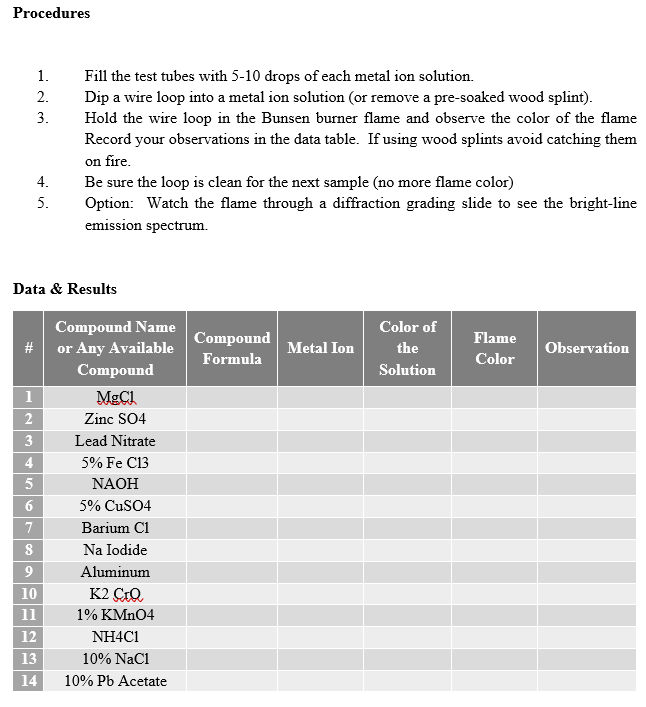Chapter22: Bulk Electrolysis: Electrogravimetry And Coulometry
Section: Chapter Questions
Problem 22.9QAP
Related questions
Question
Flame Test Experiment

Transcribed Image Text:Procedures
#
1
2
3
4
5
Data & Results
5669
7
8
1.
2.
3.
10
4.
5.
Fill the test tubes with 5-10 drops of each metal ion solution.
Dip a wire loop into a metal ion solution (or remove a pre-soaked wood splint).
Hold the wire loop in the Bunsen burner flame and observe the color of the flame
Record your observations in the data table. If using wood splints avoid catching them
on fire.
Be sure the loop is clean for the next sample (no more flame color)
Option: Watch the flame through a diffraction grading slide to see the bright-line
emission spectrum.
11
12
13
14
Compound Name
or Any Available
Compound
MgCl
Zinc SO4
Lead Nitrate
5% Fe C13
NAOH
5% CuSO4
Barium Cl
Na Iodide
Aluminum
K2CQ
1% KMnO4
NH4C1
10% NaC1
10% Pb Acetate
Compound
Formula
Metal Ion
Color of
the
Solution
Flame
Color
Observation
Expert Solution
This question has been solved!
Explore an expertly crafted, step-by-step solution for a thorough understanding of key concepts.
Step by step
Solved in 2 steps

Follow-up Questions
Read through expert solutions to related follow-up questions below.
Follow-up Question
Analysis:
- What is an ion?
- Describe what happens to the electrons in an atom when they absorb energy (from the flame)? Why does this produce a bright-line emission spectrum (rather than a continuous spectrum)?
- In terms of atomic structure, why does each metal ion produce a different color flame?
- What difficulties are there in identifying metal ions with a flame test? How could you improve the specific identification of the metal ions during a flame test?
- If it can be determined from the flame test results, what are the identities of the two unknown liquids?
- What might be some practical (and exciting) applications of metal containing compounds that create different colors of light while burning? Explain.
Solution
Follow-up Question
What is Flame Test?
What is your observations about this flame test experiment?
What is your own conclusion about this experiment?
Solution
Follow-up Question
What do you think is the problem why do we need to do the flame test experiment?
What is the purpose of the flame test experiment?
Solution
Knowledge Booster
Learn more about
Need a deep-dive on the concept behind this application? Look no further. Learn more about this topic, chemistry and related others by exploring similar questions and additional content below.Recommended textbooks for you

